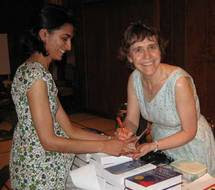The person who first recounted the deathless tale of Little Jack Horner and his Christmas (i.e. mincemeat) pie would still be trying to think of a body part rhyming with "raisin" were it not for a fortunate (for him) development in both English cuisine and usage in the 1600s. Certain dishes, for instance mincemeat and Christmas pudding, which had originally been made with prunes (dried plums), started to use raisins or currants instead, but the word "plum" continued to be used despite the change in the type of fruit. So what Little Jack's thumb encountered was actually a dried grape, just like the ingredients in your "plum" pudding.
Sugarplums, on the other hand, were never plums, not even candied ones. They were a kind of hard candy, about the size and shape of a plum, in various colours and flavours, often with wire "stems" attached. An aniseed or caraway seed served as a "pit". Sugarplums were in vogue from the seventeenth to the nineteenth centuries, just in time for Tchaikovsky and the choreographers Petipa and Ivanov to ensure their immortality by associating them with the reigning deity of the Land of the Sweets, performed here by the very lovely Miyako Yoshida of Birmingham Royal Ballet:
A very merry Christmas to all Wordlady readers; thank you for following. I hope you have many sugarplums over the holidays... and if you've never been to see Nutcracker... go!
You can catch the Royal Ballet's beautiful classic version in cinemas around the world this week. Check out locations near you here: http://ca.rohcinema.com/tickets
If
you love ballet, please check out my season of outstanding ballet
trips by clicking here and my
ballet appreciation courses by clicking here.
ballet appreciation courses by clicking here.


As always I am fascinated by your informative blog. Merry Christmas to you and may your New Year bring you health and happiness.
ReplyDeleteTo complement the verbal with a little musical Sugar Plum Fairy--check this amazing clip of people playing the piece on glasses: http://www.youtube.com/watch?v=QdoTdG_VNV4&noredirect=1
ReplyDelete